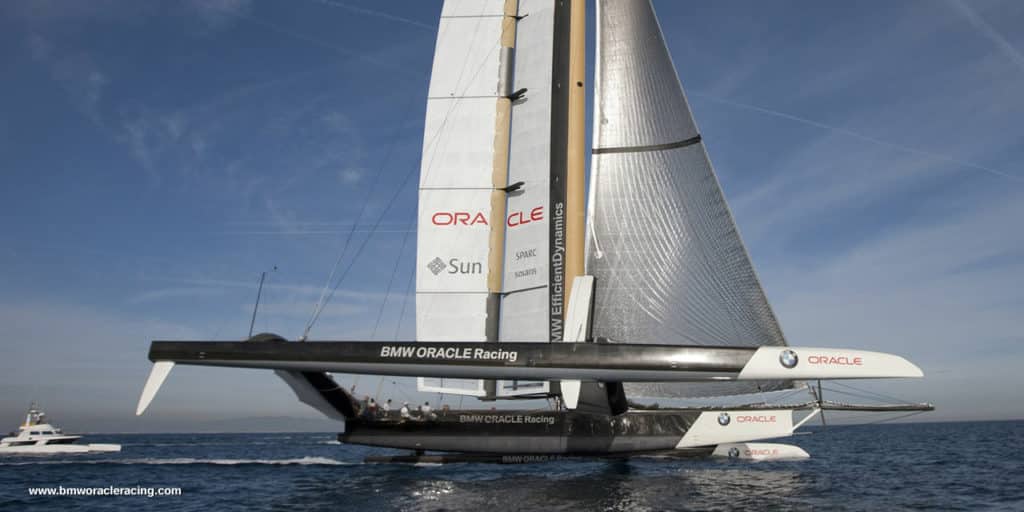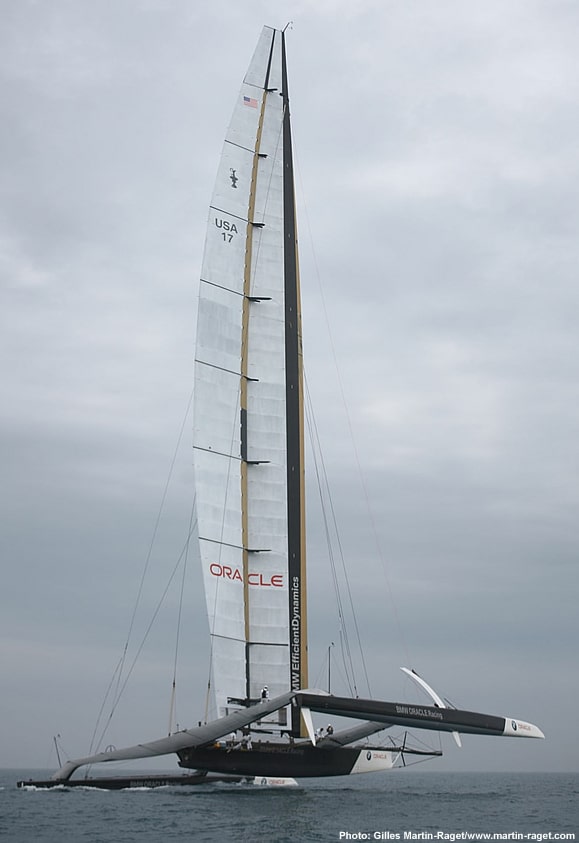
Towering over Dirk de Ridder’s head is the largest single airfoil section ever built. It’s 190 feet tall, up to 30 feet wide and 6 feet thick, and weighs almost 4 tons. It represents nearly 40,000 man-hours of work, millions of dollars, and is capable of producing more power than perhaps any other single sail. Mounted on BMW Oracle Racing’s 90-foot trimaran, it could be the key to winning the 33rd America’s Cup. De Ridder is the wing’s primary trimmer. That would seem like quite a load on one pair of shoulders, even if they happen to belong to a sturdy veteran of three Volvo Ocean Races, two America’s Cups, and one Olympic regatta.
Actually, says the 36-year-old Dutchman, compared to the traditional-a.k.a. soft-sail configuration the team used previously, the hard sail makes his job easier. With the soft sail, de Ridder would spend his day clutching a mainsheet carrying 20 tons of load and, in many respects, the structural integrity of the multi-million-dollar craft.
“With the wing, you can do everything with two very small winches and four very small hydraulic rams,” says de Ridder. “[With the soft sail] you were sort of in charge of the loading of the boat because the mainsheet transferred all the load to the headstay. Now navigator Matteo Plazzi and tactician John Kostecki are more in charge of the actual loading and how the mast sets up. So in that perspective my job has gotten a lot easier.”
For all the science and technology in this remarkable sail, it is, in theory, a tried-and-true concept. “The two-element wing, I’m not sure when it was invented,” says BMW Oracle Racing design coordinator Mike Drummond. “But it wouldn’t surprise me if it was in the 1920s or thereabouts. Within the first 10 to 20 years after the Wright brothers flew, there was an enormous explosion of people developing the math and theory of airfoils and wings. Most of that is still applicable.”
The basic design-looking at a transverse slice of the wing-is a forward section (the main element) with a hinged tail (the flap element) and a small gap in between. Angling the flap to one side or the other creates camber. That, combined with the angle of attack-the difference between the apparent wind angle and the centerline of the forward section-creates lift.
“With the two-element wing with the slot, we can achieve much higher lift coefficients [compared to a soft sail],” says Drummond. “So we can have a smaller sail area, if you like, and achieve the same power.”
The wing has slightly less “sail” area than the mainsail used on BMW Oracle Racing’s tallest conventional rig. And while the soft main was always accompanied by a head sail, the wing will likely only need one in very light air. Less sail area, of course, means less drag. Less drag means more speed.
No matter how basic the theory behind the wing; building it involved breaking a lot of new ground. No one had ever attempted to build a foil of this size and complexity. The rigid wing for Dennis Conner’s catamaran challenge in 1988 was 108 feet tall. The rigs for the C-Class catamarans of the Little America’s Cup top out at 40 feet. Outside the sailing world, the blade for the Enercon E-126 windmill measures 206 feet in length. But the chord is much shorter and the blade doesn’t contain any moving parts.
“One of the significant problems to solve was how we were going to assemble it,” says Drummond, “the logistics of figuring out how to build it, what order to build it in, and how to assemble the flaps onto the main wing, how to even assemble the ribs onto the spars.”
Even something like the white skin covering ribs-which an average person could probably step through, says Drummond, “at least in high heels”-involved a lot of thought. “We weren’t sure how much tension would be required to maintain a reasonable shape and that had quite an impact on the design of some of the elements where they get quite thin.”
And like everything with the America’s Cup, time was a factor. Theoretical work began in September 2008, but the project wasn’t given the green light until February 2009. “We designed it and built it at the same time,” he says, “So there was very little time to do design iterations..”
Because there is so much less load, trimming can be more dynamic than with the soft sail. De Ridder uses the traveler winches from the soft sail set up, with a 2-to-1 purchase, to change the wing sail’s angle of attack. The rest of the trimming is done via a small eight-button remote control. “It’s like a garage-door opener,” de Ridder says with a laugh.
The remote control adjusts the sail’s camber-equivalent to tightening or loosening the outhaul of a soft sail-and twist profile. The flap element is divided, vertically, into eight independent sections. But to change the twist takes only one button; and the twist profile will tack with the sail. The remote can also adjust the position of the top two aft elements and to offset the twist profile a bit to generate extra power when needed.

Setting the camber, says de Ridder, is largely a by-the-numbers operation. He wears a small display on his forearm, which displays both the actual camber of the sail at each hinge point as well as the optimum angles determined by the design team. “For now I really have to trust the targets,” says de Ridder. “[The design team] spent months and months designing this wing, making sure what shape we wanted.”
But, it’s not as if trimming this sail is completely a scientific process. “The art is still there because the wind [at sea] is not perfect two-dimensional wind tunnel wind,” says Drummond. “Even if you go testing in a wind tunnel or a computer wind tunnel, you don’t have what the boat’s requirements are. You can set the wing perfectly, but that may be wrong for the boat: the rudder load is too high or there’s too much leeway or not enough heel. The art is still in combing all those elements and the information to get the best performance out of the boat.”
Carrying more weight aloft has made the boat pitch a little bit more says skipper James Spithill. “But then again, it’s so efficient,” he adds. “When a soft sail pitches it creates a lot of drag, where as the wing doesn’t. I think the bigger feeling is the available power. With the soft sail it takes a bit of time to trim on. With the wing, the flow attaches and it’s just ‘Bang’!’ it’s on.”
As he gets more comfortable with the sail-and he’s able to spend less time watching the loads-Spithill says the act of steering the boat won’t be a lot different: “It’s still a real similar loop, where you’re looking at the targets, the numbers, the wind, obviously the hull, how high you’re flying and just doing that circle. From that side it hasn’t changed.”
There is one thing Spithill has changed. Once the team made the decision to build the wing, the 30-year-old Australian pursued his pilot’s license. “I just made it one of those things I had to do,” he says. “Like anything you’ve only got so much time. I figured if I had a better understanding of wings it wouldn’t hurt.”
For de Ridder, the key has been to remember that, hard or soft, it’s still a sail. “The first day, when we came in, [appendage designer] Michel Kermarec said, ‘It’s very simple. You set the camber, then you close your eyes and go sailing like it’s a soft sail: twist when you need to twist and let the sheet out when it feel like you need to let the sheet out.’ That’s the best advice I got. At the end of the day it’s just a power source and you have to keep the boat at a good heel angle and a good rudder load and match up as close to target as you can.”
This article first appeared in the February 2010 issue of Sailing World.









